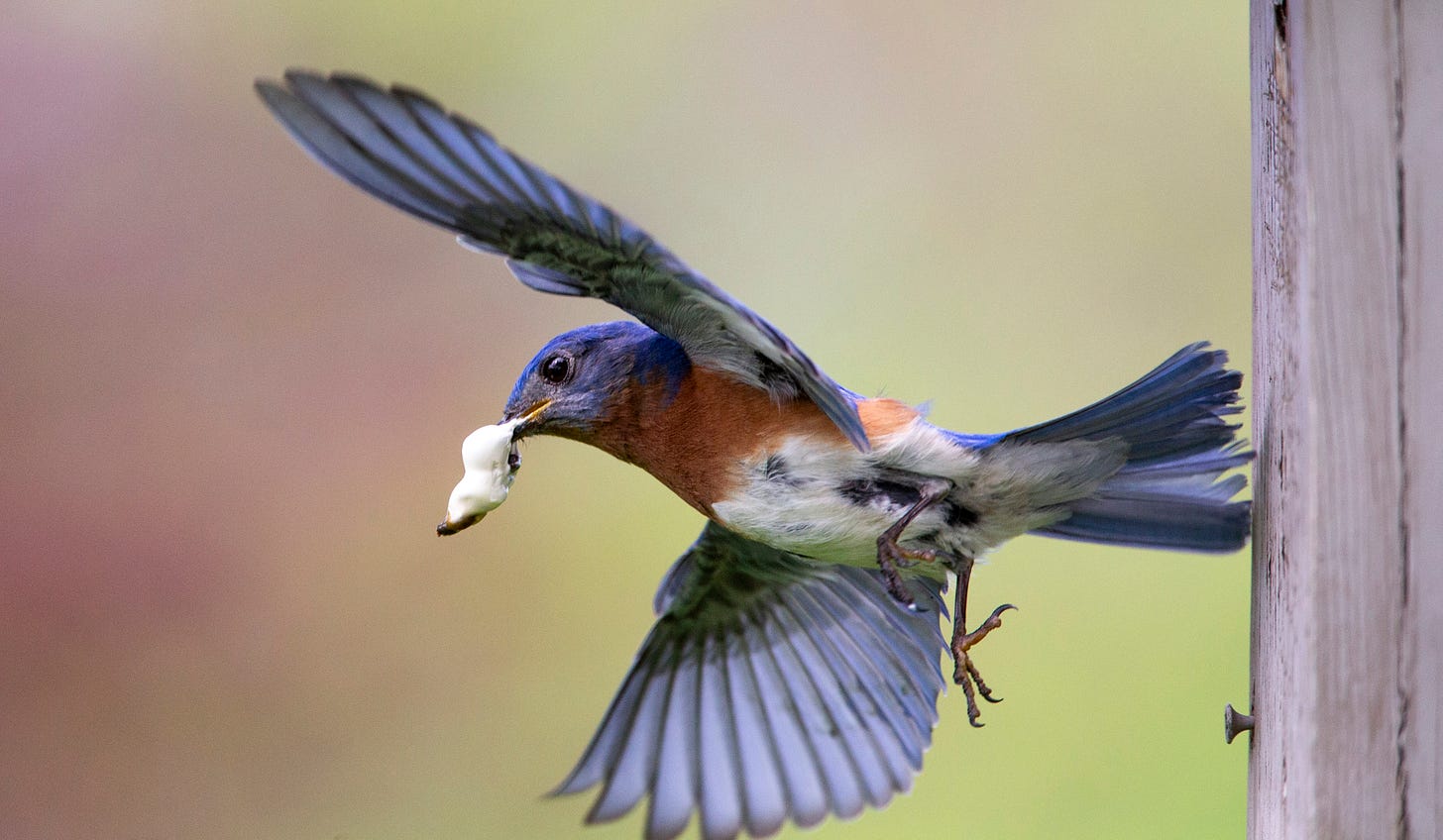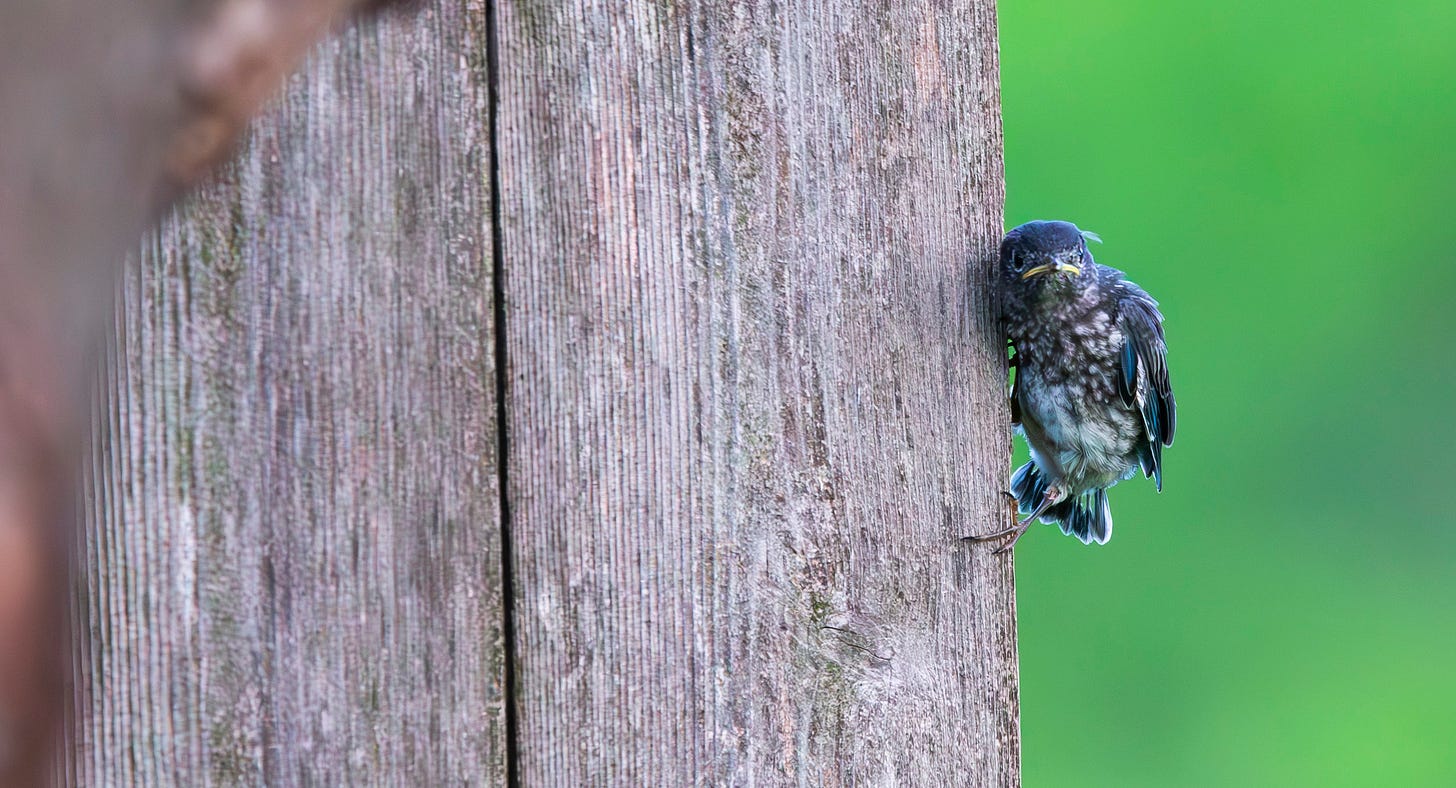Off they go, into the wild bluebird yonder
Bluebird male does double-duty as five fledglings make their first big leap
Buebird voices are, for the most part, for lack of a better, broader descriptor, gentle.
They converse in airy, whistling tura-lees and greeting and mating songs with chits and chatters scattered in as if a dainty DJ is scratching their diminutive soundtracks among the trees.
Even when I’m too close to the nest box, pulling weeds or rinsing out the birth bath, their swoops and warnings are almost stealthy. Typically, I’m aware of their low swoops and whooshes of their wings before I notice that warning chit .. chit… chit.
Not so, the vocal antics when their fledglings scatter with the wind. The chit-chat graduates to full fire-alarm mode.
Any parent could relate, especially this month when so many watch their kids head off to prom wearing their finest and cross graduation stages on their way to who knows what the future will hold.
When the little ones leave the nest, especially if the departure is less than ideal, or danger seems near, a sense of panic and need to react floods the heart. Hint to the newbies out there, that protective instinct never fades.
I doubt the same is true in the bluebird world, but in the case of our little bluebird nestlings, from Nest Attempt No. 24, they hatched throughout the afternoon of April 9 and left the nest just before sundown on the 24th. At least, most of them did.
They were on schedule. Most ornithological write-ups put the fledgling departure dates at 15 to 18 days. So, 15 it was.
Some were more on schedule than others. In a group of five, the largest I’ve recorded at our nest box, one or two will naturally be less developed than more aggressive siblings.
The female disappeared around April 19 or 20 for this brood, so the male had to pull double duty for that crucial final week of development. Feeding, taking out fecal sacs (changing diapers), and guarding against predators is a big job for one little bird, especially with five hungry mouths to satisfy.

When I realized she was gone, I went to Wild Birds Unlimited for a packet of 1,000 live mealworms. I learned last year that feeding live mealworms when young are present is crucial because they need the moisture in those juicy, live worms. Freeze-dried won’t do.
Each morning around 8:30 a.m. and evening, around 6 p.m., I’d step out the back door, start whistling, and load he feeder. The male responded quickly to my whistling, perched nearby, and before I could walk 60 feet to our porch, he would have hit the feeder for a mouthful and already have his head in the nestbox feeding the chicks.
He would fly back and forth from the feeder to the nestbox until he emptied the feeder. That made it apparent that those morning and evening dietary boosts made his day much easier.
So what happened to the female?
Who knows?
We had a nasty storm around the time she disappeared. She could have met with an accident. The nestbox remained undisturbed, and the yard has been relatively free of house sparrows and starlings that pick on bluebirds. She may have fallen fell prey to one of the hawks that frequent the open area behind the house, or possibly the damned cat that runs loose around our neighborhood and stalks our feeder station and bird bath on the regular.
When the fledglings left the nest, I heard the male’s panicked calls from my living room. He was perched on my barbecue—not a typical spot—so I immediately knew what was up.
I watched from inside for a few minutes. He chattered around our porch, the privacy fence next to the house, then some low dogwood branches out by the slough, then back to the porch, then the dogwood, and so on.

I stepped out with binoculars and spotted one fledgling on a low pecan tree branch close to the trunk, down near the dogwood that grows at its base. It looked good! It had a prominent eye ring, blue wings, and a mottled breast. It seemed to sit comfortably, which was good, given the quickly fading daylight.
The male swooped at me several times as I stood on the porch, so I began to look around the lawn, which needed a lawn mower’s attention. A little bluebird could disappear anywhere in there.
Movement at my feet clued me in. A little one had taken refuge among the coils of the dark gray garden hose I’d used that afternoon watering plants on the porch.
It hopped away and was joined by another, a few feet away, that had tucked itself in against the side of the house, not two feet from the back door.
Coupla dinks, they were. Tufts of downy feathers poking out around their heads and necks indicated they were not quite so developed as their tree-perching sibling.
The porch offers some security, but curious raccoons are not uncommon and it’s a nightly stop for that damned cat, so it was no place for these fightless balls of fluff to spend the night.
The night would be cool, and the morning would be dew-soaked, so it was back to the nestbox for these two. They showed no resistance as I bent to scoop up one in each hand. I put them back in the nestbox, put a load of worms in the feeder, and peace returned to the backyard as the sun set.

Dawn saw the male busy at the feeder, so I grabbed my camera and walked out to see what I could see. One of the two I put in the box had already jumped out. It was at the base of the neighbor’s fence, trying its best to go upward. It flapped its wings madly while climbing a corner where the chain link met the wooden privacy fence.
Others, I’m guessing the other three, apparently had a safe night up in the pecan tree, much higher than the one I’d seen at sunset. The male made several trips up there with worms, so I had a good idea where they were. Still, I failed to spot a single chick. They are good at hiding!
Meanwhile, the fence climber continued its slow ascent and, finally, the last of the brood stuck its grumpy mug out of the nestbox and called for breakfast, which the male provided.
Eventually, it exited, flapping its wings fruitlessly. It clung to the box momentarily, its head turned back toward the hole, but it soon lost its grip and fluttered unceremoniously, straight to the ground. It, too, flutter-hopped its way to the neighbor’s fence and flapped and climbed. Both, eventually, executed the 5-foot flight from the top of the fence to the low branches of our redbud tree. From there, they would have to cover a 20-foot gap to the dogwood and pecan tree.
I hope they made it and will return to the feeder someday with the male. I whistle and put out worms every morning. I haven’t seen them, but the male continues his visits.
Another question is whether the male will find another mate to re-nest in the same box. It is cleaned and ready. Typically, the female will build a new nest about a week after the first brood exits. Nothing so far here.
This may be the end for bluebirds nesting in our yard this year, but successfully seeing five leave the nest when the stats show that only 50 percent of bluebirds survive their first year is a good contribution.
We all leave the nest, some with greater flair and immediate success than others, but even when the departure is less than ideal, a sense of hope—and a little help from a friend—serves better than worry and panic every day.






Good story. You are a generous blue bird feeder.